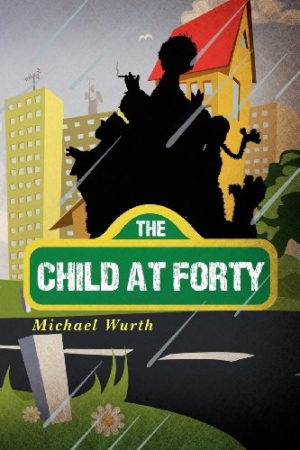The Child at Forty
In his first novel, screenwriter and playwright Michael Wurth provides an ample amount of context for four intersecting lives. It is this significant amount of background that makes the events of his story so compelling. Wurth’s ability to create complicated, damaged, but ultimately earnest characters drives The Child at Forty and gives readers an opportunity to understand the full emotional landscape of the author’s cast.
First introduced is five-year-old Steven, whose mother tries to beat a train at a crossing and fails, throwing the boy into early chaos and leaving him with a vague longing throughout his life. Next is Jeremy, a typical suburban boy whose teenage life is darkened by divorce. Following him is Tiffany, who has a domineering father and feels humiliated at having to wear a back brace. Katherine is the final character; she comes into the world at a time when her father gets drunk more and more often at a neighborhood bar.
The characters travel through their childhoods like astronauts on a hostile planet: they try to see the beauty around them while defensively watching for trouble. When their lives become entangled, each character reveals the hope and the damage from his or her early years, and the results aren’t always pretty.
As a thread through the characters’ lives, Wurth brings in frequent references to Sesame Street, The Electric Company, and The Muppet Show, and throws in an occasional nod toward Dr. Spock’s Baby and Child Care, all of which were intended to guide parents and children through the challenges of growing up. But Wurth’s characters see them first as comforting, and then as a burden.
The simplistic and moralistic lessons of the television shows grow increasingly sour as the book’s quartet of characters age, until finally Steven rebels against them altogether. But like an omniscient god, one of the Sesame Street personalities chimes in to defend the program’s purpose, and to give a lesson that is lost on many people, including those in the novel. “We are happy when we decide to be happy,” the TV character says. “If we don’t, we have to examine what it is in ourselves that has failed us: blaming others isn’t right or wrong, it’s simply unproductive. If I gave any lesson in the world, that’s it. Watch the footage. I never promised anything more or less than that.”
The use of Sesame Street, in particular, creates a powerful parallel between what is expected of the characters—and of people in general—in contemporary society, and what is truly going on in their lives. That gap between how people “should” behave and their actual actions creates empowerment in some and frustration in others. By utilizing that device, Wurth brings more depth to the novel, and also makes the outcome for some characters even more heartbreaking.
Witty and charmingly written, Wurth’s novel introduces a group of memorable characters whose rich emotions make them relatable and real, and who can be remembered long past the last page.
Reviewed by
Elizabeth Millard
Disclosure: This article is not an endorsement, but a review. The publisher of this book provided free copies of the book and paid a small fee to have their book reviewed by a professional reviewer. Foreword Reviews and Clarion Reviews make no guarantee that the publisher will receive a positive review. Foreword Magazine, Inc. is disclosing this in accordance with the Federal Trade Commission’s 16 CFR, Part 255.

